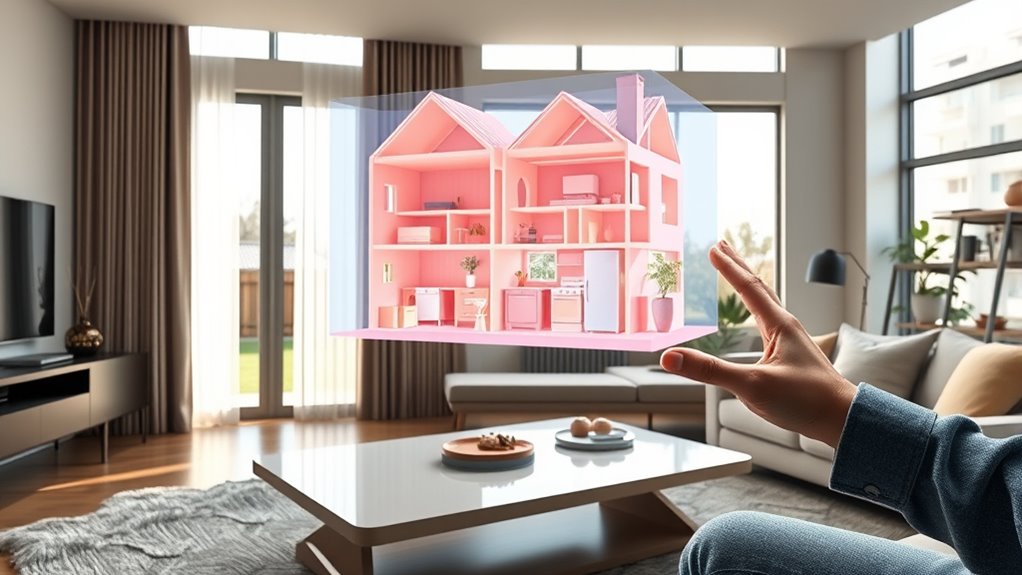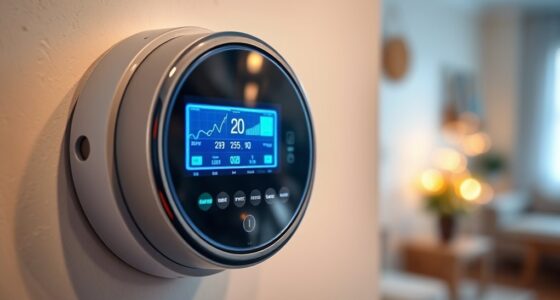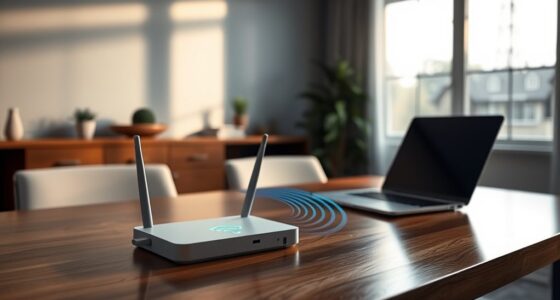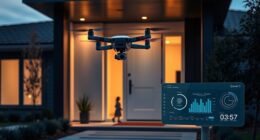Digital twins are virtual copies of your home that provide real-time data on your systems and devices. They help you monitor energy use, detect issues early, and optimize performance without lifting a finger. By connecting your smart home products, these digital replicas allow you to schedule maintenance, prevent costly repairs, and keep your home safe and efficient. If you’re curious about how they work and can transform your living space, keep exploring.
Key Takeaways
- Digital twins create real-time virtual models of your home’s systems to monitor performance and identify issues proactively.
- They enable seamless integration and control of smart home devices through a single interface or voice commands.
- Digital twins help optimize energy use, detect inefficiencies, and reduce utility costs by analyzing usage patterns.
- They predict maintenance needs, alert homeowners about potential problems, and prevent costly breakdowns.
- Utilizing digital twins enhances home safety, comfort, and efficiency through continuous monitoring and automatic adjustments.
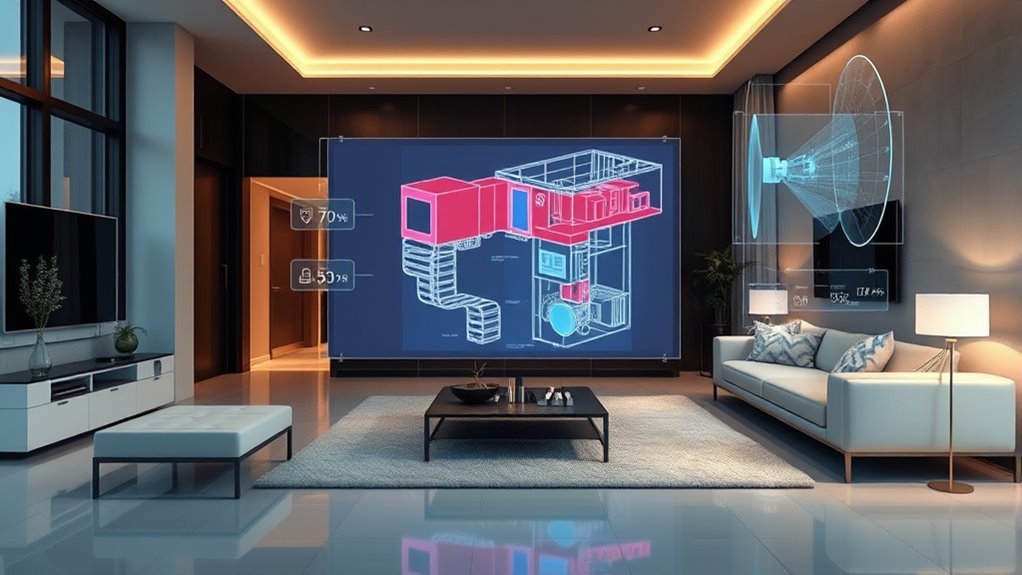
Digital twins are virtual replicas of physical assets, processes, or systems that enable real-time monitoring and analysis. When applied to your home, they become powerful tools that give you a detailed, dynamic view of how your property functions. Through smart home integration, these digital twins connect seamlessly with your devices—thermostats, lighting, security systems, and appliances—allowing you to see their status at a glance and understand how they interact. This integration makes managing your home more intuitive, giving you control through a single interface or even voice commands.
Digital twins offer real-time insights into your home’s systems for smarter, more efficient living.
With a digital twin of your house, you can observe energy consumption patterns, identify inefficiencies, and optimize your system for savings. For example, if your heating system is consuming more energy than usual, the digital twin detects this anomaly early, alerting you before it becomes a costly problem. This proactive approach is a core benefit of predictive maintenance, which leverages real-time data to forecast potential issues before they cause disruptions. Instead of waiting for a breakdown, your digital twin warns you that a filter needs replacement or a component is wearing out, so you can schedule repairs at your convenience.
Predictive maintenance powered by digital twins reduces downtime and extends the lifespan of your home’s equipment. You won’t have to guess when something might fail or rely solely on routine check-ups. Instead, the system continuously analyzes data from sensors embedded in your appliances and infrastructure, providing insights that keep everything running smoothly. This technology helps you avoid unexpected repairs, saving you money and giving you peace of mind.
Imagine waking up to a home where your digital twin has already optimized your HVAC system overnight, ensuring comfort while conserving energy. As you go about your day, the system monitors all connected devices, adjusting settings to improve efficiency or alerting you to issues like a leaky pipe or a malfunctioning appliance. The continuous feedback loop ensures your home remains safe, efficient, and comfortable without constant manual intervention.
In essence, digital twins transform your home into a smart, self-aware environment. They empower you to maintain everything proactively, prevent problems before they escalate, and make smarter decisions about energy use and maintenance. This technology not only simplifies home management but also enhances safety, comfort, and cost savings. By embracing digital twins, you step into a future where your home actively works for you, constantly learning, adapting, and improving through the power of real-time data and predictive insights.
Frequently Asked Questions
How Secure Are Digital Twins From Cyber Threats?
You might wonder how secure digital twins are from cyber threats. They can face cybersecurity risks like hacking or data breaches if not properly protected. Your data privacy is also at stake if sensitive information isn’t safeguarded. To stay safe, guarantee strong security measures, regular updates, and encryption are in place. Being proactive helps protect your digital twin from potential cyber threats and keeps your home data private.
Can Digital Twins Predict Future Home Repairs Accurately?
You might wonder if digital twins can predict future home repairs accurately. They excel at predictive maintenance by analyzing real-time data, helping you catch issues early. However, their accuracy depends on data quality and completeness. If the data is precise and extensive, digital twins can provide reliable predictions, reducing unexpected repairs. Still, keep in mind that they’re tools to assist, not guarantee, every repair prediction will be spot-on.
What Is the Cost of Implementing a Digital Twin System?
You wonder about the cost of implementing a digital twin system. To understand this, you should conduct a thorough cost analysis, considering implementation expenses like sensors, software, and integration. These costs vary based on your home’s size and complexity. While initial investments might seem high, they can lead to long-term savings through efficient maintenance and repairs. Planning carefully helps you balance upfront costs with future benefits.
How Often Is Data Updated in a Digital Twin?
You wonder how often data refresh frequency occurs in a digital twin. Typically, it depends on the system’s setup, but many digital twins offer real-time updates, meaning data is continuously refreshed to reflect the latest conditions. Some systems might update every few seconds or minutes, while others could have less frequent refresh rates. You should check the specific digital twin’s capabilities to understand its real-time updates and data refresh frequency.
Are Digital Twins Compatible With Smart Home Devices?
Imagine your smart home devices working seamlessly with a digital twin. You’d get enhanced home automation and smarter energy management, all in real-time. Digital twins are often compatible with various smart home devices, allowing you to monitor and control systems effortlessly. This integration simplifies maintenance, optimizes energy use, and improves safety, giving you a smarter, more efficient home experience. So yes, digital twins can certainly work with your smart home setup.
Conclusion
So, next time your home’s digital twin warns you about a leaky pipe, just remember—you’re basically living in a sci-fi sitcom where your house snitches on you. Who knew virtual copies could be your new best friends or your biggest tattletales? Maybe soon, your smart fridge will gossip about your midnight snacks. Until then, embrace this high-tech spy game—because what’s more fun than having your house watch your every move?
